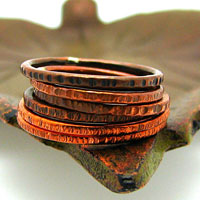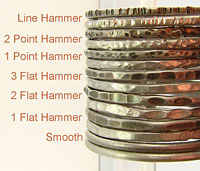Luster Metal Works: Transforming Metal
 Copper bracelets by Luster Metal Works
Copper bracelets by Luster Metal WorksPhotograph courtesy of Susan Harbourt
In rural Illinois, population 500, the farmers' plows regularly unearth the phone wires beneath the corn fields-disrupting the locals' communications. Throughout the planting season and its undependable communication service there sat a sagging Edwardian house. The original antique electric system was installed during the Rural Electrification of the 1930s and is comprised mostly of raw copper material. Over a hundred years old with miles of copper wire within its walls, the home's new owner/fixer-upper, Susan Harbourt, felt a tick of inspiration.
After pulling miles of glinty sand dune heaps of copper wire onto her basement floor, Harbourt became eager to mold the raw old material into a lustrous treasure. Soon after, she founded a line of sterling silver and copper artisan jewelry named aptly, Luster Metal Works. Pounded out in a shop shared by her husband's antique car restorations, Harbourt has accomplished hundreds of custom designs, forming classic messages of love, commitment, and philanthropy.
Her parents have both influenced her aesthetic: Harbourt's father a successful aerospace engineer and her mother an English major, she finds the design spectrum sparring within her as she creates her work. "I have both of them warring inside of me," she says of her parents, "artist and engineer… trying to get out."
As a young woman, Harbourt's training in materials engineering taught her to see all the possibilities in metal. While attending Virginia Tech on scholarship, her skills led her toward a successful career in product development. But she soon left that world for motherhood and a chance to design her own products, and has been designing jewelry ever since.
 Custom designs made by antique hammers
Custom designs made by antique hammers Photograph courtesy of Susan Harbourt
The first piece she ever made was her husband's wedding ring. It became the first of many symbolic commitment ceremonies for which she would craft custom jewelry. Her beloved's ring was designed, re-designed and re-designed again in wax, copper, and sterling silver with symbolic waves, signifying his connection to the water. "The waves represented [his surfing hobby,] a part of his character that was fun," Susan reflects, "but also the love that we had for each being wide and deep like an ocean."
Today Harbourt admits she needs to shuffle her husband's projects to the side in order to find her work space beneath old carburetors and dismantled car engines, but is content when playing with the "luster" in her jewelry materials. "Copper is such a wonderful metal that transcends almost all areas of everyday life… It is in our money, our jewelry, our houses, our art, our cook wear, our body, it has medical and even antimicrobial benefits," she says passionately. "It is an amazing metal that responds so beautifully to artistic manipulation and was revered in the ancient world."
Harbourt's alliance is not only to ancient metals, but antique tools as well. She reveres handmade hammers, which she scores from thrift stores, shops and local yard sales. "When anyone stops by to see me they can often hear me melodically hammering away; tink, tink, tink," she says.
One can tell the hammermarks are part of Harbourt's trademark. Her bracelet and ring designs often bear the mark of one of her antique hammers, roughly chipped into a circular glitz. They often come in similar shapes with different stories, materials, and colors attach to them-which makes a nicely chosen accessory.
"I think jewelry often reflects the phase of life one is in," she suggests. "When you are engaged, you celebrate that with a diamond ring, when you marry you seal that with a ring. When I was a young professional I wore jewelry that was vibrant, trendy, and made a statement. Now that I am a little older, I prefer jewelry that is classic and can be worn with jeans and a t-shirt as well as a cocktail dress."
Harbourt's interest is in transmogrifying old materials to new, often using old resources around her. Her process often involves several well-planned steps. After concept sketches, she creates her prototypes in copper because of its ability to be shaped and hand-tweaked. Though she often goes on to cast those pieces in silver, she admits she often saves the copper trials as her own. "Part of the reason is to work out the design concept with an economical and forgiving metal, but the real reason is because I love copper and tend to keep the prototype for my own collection."
Looking toward the next decade, Harbourt looks forward to incorporating gold, palladium and other materials into her designs, focusing specifically on phase diagrams and crystal growth in metals.
She looks forward to furthering her designs for philanthropic foundations and has a special affinity for commitment ceremonies. "It is an honor to be asked to make such an intimate item as the token that represents the commitment and love shared between a couple," Harcourt says. "It is also a little amazing to think of all the memories and events that ring will bear witness to in that couples lives."
Resources:
Also in this Issue:
- Kinetic Art: Copper in Motion
- Anita DiPietro Designs
- Luster Metal Works: Transforming Metal
- Speaking Through Copper
- Automata: Contemporary Mechanical Sculpture
